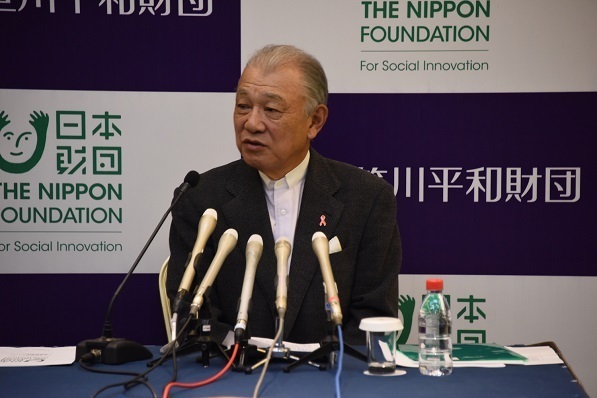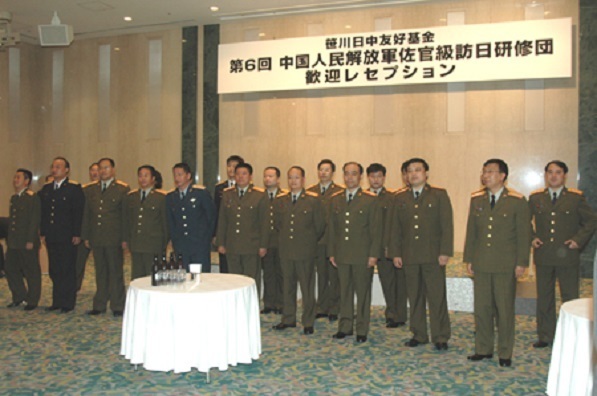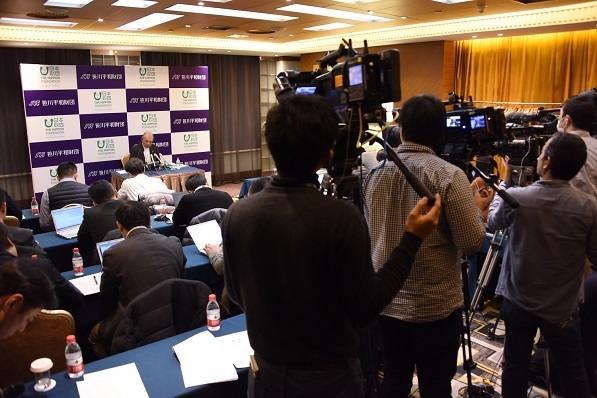Japan-China Field Officer Exchange to Restart after 6 YearsChinese PLA delegation may visit Japan in April, mutual deployment for future disaster relief being considered
The Japan-China Field Officer Exchange program, which was halted in October 2012 in connection with Japan’s nationalization of the Senkaku Islands (referred to as the Diaoyu Islands in China), is set to restart after a six-year suspension. On February 5, Yohei Sasakawa, Honorary Chairman of The Sasakawa Peace Foundation and Chairman of The Nippon Foundation, met in Beijing with Major General Hu Changming, Chief of the International Military Cooperation Office of the Central Military Commission. During the meeting, they reached a basic agreement to extend the program for another five years, and for a group of roughly 20 PLA field officers to visit Japan as early as April.

At a meeting in late January, Japanese Foreign Minister Taro Kono and Chinese Foreign Minister Wang Yi noted that this year marks the 40th anniversary of the conclusion of the Treaty of Peace and Friendship between Japan and China, and confirmed their desire to accelerate an improvement in relations between the two countries including through various meetings between the two countries’ leaders. At their February 5 meeting, Mr. Sasakawa and General Hu discussed potential areas of future cooperation, including the dispatching of joint rescue teams from the Japan Self Defense Forces and the People’s Liberation Army in the event of major disasters in third countries, and General Hu also proposed the expansion of cultural activities in areas like calligraphy.

Three points were confirmed at the meeting: (1) Private-sector exchange programs between the two countries carried out over the past 11 years have played a proactive role in promoting mutual understanding among the next generation of leaders of the Self Defense Forces and the People’s Liberation Army; (2) This program has been extremely meaningful in terms of improving safety for both Japan and China, and should continue for five more years under private-sector leadership; and (3) Efforts would be made to reopen the administrative office, staffed by The Sasakawa Peace Foundation and the China Institute for International Strategic Studies, at an early date from the spring of 2018.

General Hu participated in the exchange program in 2007, and noted, “This kind of private-sector program benefits both countries. It is unfortunate that it was terminated for political reasons.” He expressed his desire to restart the program by April, if possible, and agreed to the dispatching of joint disaster-relief teams. He also expressed positive views on other aspects, commenting that he would like to see a broader scope of discussion between young officers of the two countries participating in cultural programs and the exchange program, and for the number of participants to increase.
At a press conference for Beijing-based Japanese media following the meeting, Mr. Sasakawa expressed his hopes, commenting, “The fact that we have had this discussion itself is globally significant.” Along with announcing the points agreed to, he explained that he intended to meet soon with officials at the Japanese Ministry of Defense and Self Defense Forces to brief them on the meeting and discuss how to handle future visits by Chinese officers. In response to a question about what would happen if circumstances led to another suspension, Mr. Sasakawa replied, “We will move forward taking into account past cases.”

The exchange program was launched in 2001, primarily by the private-sector organizations The Sasakawa Peace Foundation and the China Institute for International Strategic Studies, and ran until 2012, when it was suspended at China’s request in connection with the Senkaku Islands issue. During those 11 years, 126 members of Japan’s Self Defense Forces and 207 members of China’s People’s Liberation Army participated in exchanges that included visiting each other’s bases, tours, and lectures. Even when Japan-China relations were strained at the time of Junichiro Koizumi’s visits to Yasukuni Shrine when he was prime minister, the program continued, bringing attention to this unique, private-sector-led undertaking.
Since the Senkaku Islands dispute intensified in 2012, educational exchanges between Japanese and Chinese defense officials have been put on hold, but the two governments are currently working toward their restart. As a private-sector project, the Japan-China Field Officer Exchange program is expected to become a core activity for direct exchanges among the next generation of young officers.
Contact
Communications Department
The Nippon Foundation
- E-mail:cc@ps.nippon-foundation.or.jp



